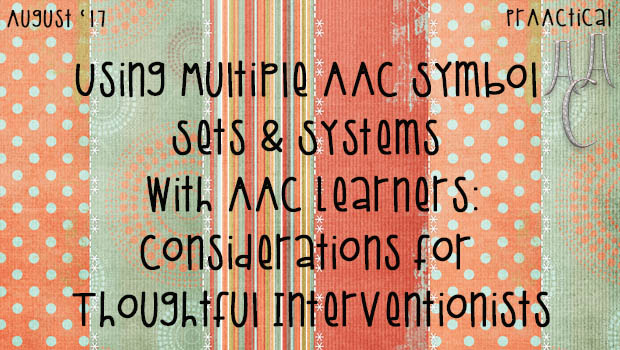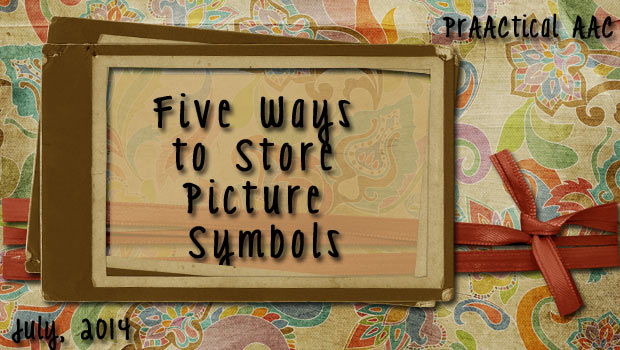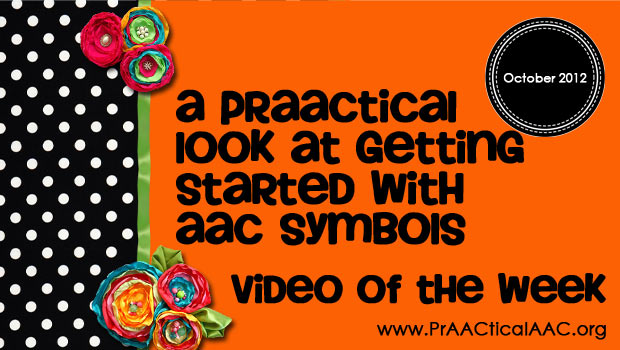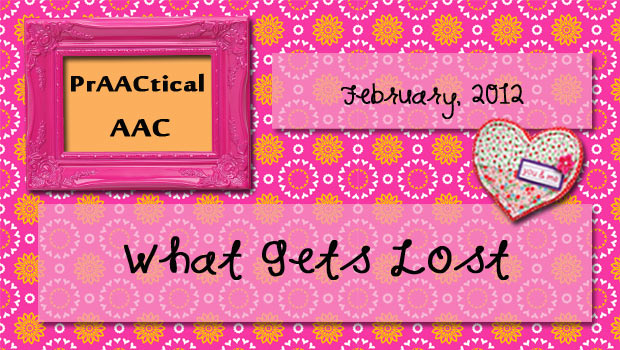Using Multiple AAC Symbol Sets and Systems with AAC Learners: Considerations for Thoughtful Interventionists

PCS, Pixons, Minspeak symbols, Smarty Symbols, Symbol Stix, CoughDrop Symbols, ARASAAC symbols, Mulberry symbols, Lesson Pix, Sclera symbols, and more.
In terms of AAC symbol options, we are living in plentiful times. It isn’t uncommon to see situations like Jonah’s. On a typical school day, Jonah is likely to encounter at least three types of pictures for the same words. He has Smarty Symbols on his AAC app and a classroom core board with PCS, and is using instructional materials using Symbol Stix. These are each great ways of visually representing language, but here’s something to think about: Does it help or hurt Jonah to have 3 different pictures for the same word?
There are many options in symbol sets and systems, and each has its own strengths and weaknesses. Here are some things to think about as you and your team are making these decisions.
- There is no empirical evidence that one type of symbol is superior to another for all AAC clients, but there may certainly be differences for a specific individual. That’s why it is a best practice to evaluate the kind of symbol to use as part of an AAC assessment rather than picking one at random or using one based on our own convenience. (See the Beukelman & Mirenda text for 5 assessment tasks that help us figure this out.)
- From a learning perspective, it makes sense to have a consistent symbol type across the expressive tools that the client will use. Symbols for object nouns, action verbs, and a few other things look fairly similar when represented in various AAC symbol sets. They can be pretty transparent, making it fairly easy to find the symbols for ‘drink’ or ‘backpack’ in a symbol set that is different than the one your client is used to. If your learner is using an AAC system that is rich in core vocabulary, though, check to see how the symbols for those words look when depicted with various types of symbols. As we see from the examples below, the differences are significant.

When we use one way of representing a word like ‘do’ in the SGD and another type of symbol to represent that word in the manual communication board, it’s likely to slow down the learning process. It’s important for us to be aware of inconsistencies in the symbol set in the no tech, low tech, and high tech AAC that our learners use and make thoughtful decisions among those.
- AAC users who are proficient in using their SGDs or AAC apps may not be bothered by this, particularly if the symbols for each word is in exactly the same place in every AAC tool they use. Many of us have worked with AAC users who, through years of experience, can successfully use their SGDs without even seeing the symbols on the overlay or screen. One of my former employees, who used Minspeak accessed through quadrant scanning on a device with 144 locations, could carry on a conversation with a completely blank overlay. His strong motor plan and intact receptive and expressive language skills allowed him to do this without a noticeable reduction in communicative rate.
- For those who are still developing their competency with AAC systems, though, it can be a significant barrier. When our AAC learners have to think about how a word is symbolized, it can increase their errors, slow them down, and cause stress or frustration.
- In these situations, you’ll need to determine whether the reason for the barrier (i.e., using multiple symbol sets) justifies the impediment to the learning process.
Bottom Line
We shouldn’t assume that representing a word one way on one AAC tool and representing that word with a different symbol on another AAC tool is inconsequential. If there isn’t a compelling reason for our AAC learners to have multiple ways of representing the same words on their various expressive communication tools, it may be best to stick with a single symbol set or system to depict their lexicon. Let’s make these decisions thoughtfully, using data to guide us.
How does this apply to the learning materials, like worksheets, task baskets, and adapted books? And what about visual supports, like schedules, first/then boards, and contingency maps? More on that in a future post.
———————————-
Beukelman, D.R., & Mirenda, P. (2013). Augmentative and Alternative Communication: Supporting Children and Adults with Complex Communication Needs, 4th Edition. Baltimore, MD: Paul H. Brookes Publishing Company.
Filed under: Featured Posts, PrAACtical Thinking
Tagged With: AAC system, picture symbols
This post was written by Carole Zangari





7 Comments
THIS!! 🙌🙌🙌🙌
Completely and UTTERLY agree!!
This is such an important issue. We are lucky to have many AAC sets and systems to consider during the assessment process. Our clients benefit from consideration of all the means to represent language including single meaning symbols, multiple meaning icons and alphabet based displays. You bring up a vital point in terms of motor planning. We surround our clients in rich visual supports to scaffold receptive and expressive language and to promote expected behaviors and participation. To achieve motor automaticity for expressive language, we know that symbols must be consistently placed on displays. We know this in accessing out smart phones. We are able to type with our thumbs because the key locations are always in the same location. If we rotated through other keyboard layouts and alphabets across our day, our speed and accuracy would surely be negatively impacted. It stands to reason that the same would hold true for visual supports such as road signs. If several different languages are used, comprehension would be impaired (unless of course we are fluent in all the languages used). More research is needed on the effect of varying symbol sets and systems across AAC displays and visual supports for our clients.
This discussion is both interesting and seems to pop up in regular intervals. This is my take as an evaluating SLP who provides over one hundred assessments per year, the majority being new SGD users. The use of multiple symbol systems is not inherently a bad idea and probably provides for generalization of learned vocabulary. This is relatively easy with fringe words that are easily represented with pictures. Core vocabulary gets a little trickier because these words are not easily represented using pictures. Instead of asking which symbol system is best for this user, the assessment process should try to determine how well the person with complex communication needs is able to apply their vocabulary knowledge to the meaning the symbols are being used to represent. The other part of the discussion relates to teaching symbol use and generalization. Gail Van Tatenhove talks about teaching the meaning of core vocabulary icons using stories…every icon has a story. The word “do” for example is represented by a string around a finger that is used as a reminder to do something. The story for a PCS symbol that represents do may be using hands to do something. The story behind the SymbolStix icon may be that the character is reaching out his hand and getting ready to do something. My point is that maybe it is less the icon, and more of a matter of how AAC practitioners are using the icons to provide a framework for vocabulary generalization. I think the bigger issue relates to persons with complex communication needs who have never had a word based AAC system. The lack of semantic knowledge and restricted generalization of word knowledge and use is overwhelming.
I would love to hear other people’s thoughts on how to incorporate large manual language boards in a classroom for modeling during whole group instruction, etc., when you have students who use different AAC systems/symbol sets. How would you handle this?
I think I would try to identify AAC mentors in the classroom. The mentors could be peers or paraprofessionals. As the teacher is modeling on the classroom core board, the mentors would be modeling on the user’s SGD. It would be helpful if the mentors were aware of the vocabulary before the lession.
That’s my question as well. It’s impossible to match everything up with the same symbol sets 🙁
How can I get a sample for pictures on symbol stick. I am looking for pictures like fruits, snacks, and toys.